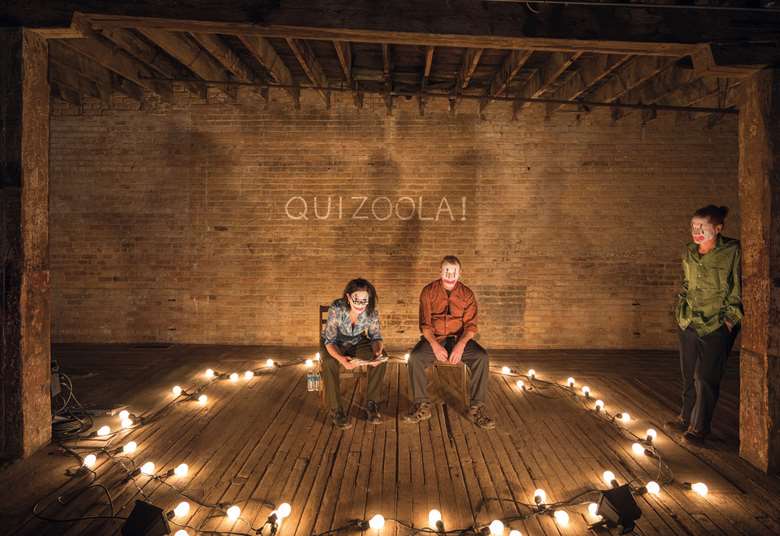Practitioner focus: Forced Entertainment
Rebecca Thompson
Tuesday, October 1, 2019
A practitioner focus on theatre company, Forced Entertainment

David Schalliol
Forced Entertainment (FE) have been described by the Guardian as having produced ‘some of the most exciting and challenging theatre of the past few decades. They were founded in 1984 by Robin Arthur, Tim Etchells (Artistic Director), Richard Lowdon (Designer), Claire Marshall, Cathy Naden and Terry O’Connor, and are based in Sheffield. They tour their work nationally and internationally, crossing boundaries between theatre, installations, digital media, the internet and photographic projects.
Influences and methodology
In the foreword to Etchells’ book Certain Fragments, inevitable comparisons are made to The Wooster Group and other artists affiliated with the avant-garde. Aspects of FE's work could be accompanied with commonly taught-in-school practitioners like Artaud; particularly considering how they like to challenge and provoke their audience. However, the long-term collaboration between the same individuals, for over 30 years, has been a key factor in enabling them to develop what FE describe as a ‘shared language’ and a rehearsal repertoire centred on improvisation.
Key features of FE performances
- Use of fragmented texts and collage like structure
- A concern with contemporary issues
- The ‘contract’ with the audience
- Durational and task-based performance
- Games, competitions and storytelling.
Themes
Persistent themes within the FE's work have been love, sexuality, confession and failure. Their performances often have distinct strands, including theatrical works such as Bloody Mess (2003), durational and task-based performances like Speak Bitterness (1994) and documentary shows including The Travels (2002). They regularly employ TV monitors, cardboard signs, face paint, party shop costumes and wigs as part of their action and mise-en-scène.
Exercise 1: Q&A
This exercise introduces students to the branch of FE's work that is underpinned with tasks and is often durational, such as Quizoola! (1996), which is performed as a 6 or 24-hour version. The piece is described by the company as ‘part game and part improvisation’ involving two performers continually asking and answering questions. Questions range from the mundane to intimately philosophical; answers might be true, improvised or fabricated.
In pairs, students label themselves A and B. Give A the list of questions, so they choose what to ask. B answers. Questions could entice students to draw on experience: ‘What was the best meal you ever had?’ or provoke improvisation: ‘Why is the Earth round?’. Emphasise that answers can be untrue. After several minutes A and B swap (give B new questions). Ask students to feed back how it felt to be put on the spot.
Next ask students to write questions on strips of paper. Create an audience and invite a pair of students to ask and answer the new questions, which questioners pick at random. Add the rule that the questioner can ask ‘Do you want to stop?’. If the answer is yes, the roles are swapped. This reflects the rules of Quizoola! Once different combinations of pairs have performed, discuss these questions:
- How does the addition of an audience change the ‘game’?
- How does it feel when you struggle to answer?
- What it is like to watch the struggle?
Exercise 2: Table-top prop box
The Complete Works: Table-Top Shakespeare (2016) entailed individual performers retelling a Shakespeare play using household objects at a table. The aim of this exercise is to recognise the potential of object-theatre.
Begin with a game of ‘This is not an umbrella it's a…’ Participants take it in turns to enter the circle and transform the umbrella into something new. Whoever guesses the new function converts it next. Use this as an opportunity to reflect on what makes a successful transformation.
Gather a selection of everyday objects. Students must select an item. Replay the game but this time they use their new item.
In small groups give students a fairytale to retell. Using their chosen objects as characters in the story, they should create a tabletop performance. Give students time to improvise and then show. Discuss what could be refined for performance. It may help to show a clip from FE's performances of The Complete Works (available online).
Exercise 3: Task-based research
The Travels (2002) began with FE company members being tasked by Etchells to go to streets with intriguing names across England. Notes and photographs they made formed the basis of a documentary style performance. Set students a task to complete individually. For example: Everyone chooses a piece of music with weather in the title and investigates its origins, or everyone observes activity in a public place on a specified day and time. Students could share the notes and other materials with each other and explore linking/contrasting themes between them as a starting point for devising.

